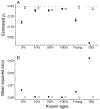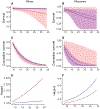Joint estimation of growth and survival from mark-recapture data to improve estimates of senescence in wild populations
- PMID: 31471965
- PMCID: PMC7493972
- DOI: 10.1002/ecy.2877
Joint estimation of growth and survival from mark-recapture data to improve estimates of senescence in wild populations
Abstract
Understanding age-dependent patterns of survival is fundamental to predicting population dynamics, understanding selective pressures, and estimating rates of senescence. However, quantifying age-specific survival in wild populations poses significant logistical and statistical challenges. Recent work has helped to alleviate these constraints by demonstrating that age-specific survival can be estimated using mark-recapture data even when age is unknown for all or some individuals. However, previous approaches do not incorporate auxiliary information that can improve age estimates of individuals. We introduce a survival estimator that combines a von Bertalanffy growth model, age-specific hazard functions, and a Cormack-Jolly-Seber mark-recapture model into a single hierarchical framework. This approach allows us to obtain information about age and its uncertainty based on size and growth for individuals of unknown age when estimating age-specific survival. Using both simulated and real-world data for two painted turtle (Chrysemys picta) populations, we demonstrate that this additional information substantially reduces the bias of age-specific hazard rates, which allows for the testing of hypotheses related to aging. Estimating patterns of senescence is just one practical application of jointly estimating survival and growth; other applications include obtaining better estimates of the timing of recruitment and improved understanding of life-history trade-offs between growth and survival.
Keywords: growth; hazard; mark-recapture model; painted turtle; senescence; survival.
© 2019 by the Ecological Society of America.
Figures


Comment in
-
Joint estimation of growth and survival from mark-recapture data to improve estimates of senescence in wild populations: Comment.Ecology. 2022 Jan;103(1):e03232. doi: 10.1002/ecy.3232. Epub 2020 Dec 23. Ecology. 2022. PMID: 33103239 No abstract available.
-
Joint estimation of growth and survival from mark-recapture data to improve estimates of senescence in wild populations: Reply.Ecology. 2022 Jan;103(1):e03571. doi: 10.1002/ecy.3571. Epub 2021 Nov 24. Ecology. 2022. PMID: 34706059 No abstract available.
References
-
- von Bertalanffy L 1938. A quantitative theory of organic growth (inquiries on growth laws. II). Human Biology 10:181–213.
-
- Colchero F, and Clark JS. 2012. Bayesian inference on age-specific survival for censored and truncated data. Journal of Animal Ecology 81:139–149. - PubMed
Publication types
MeSH terms
Grants and funding
LinkOut - more resources
Full Text Sources
